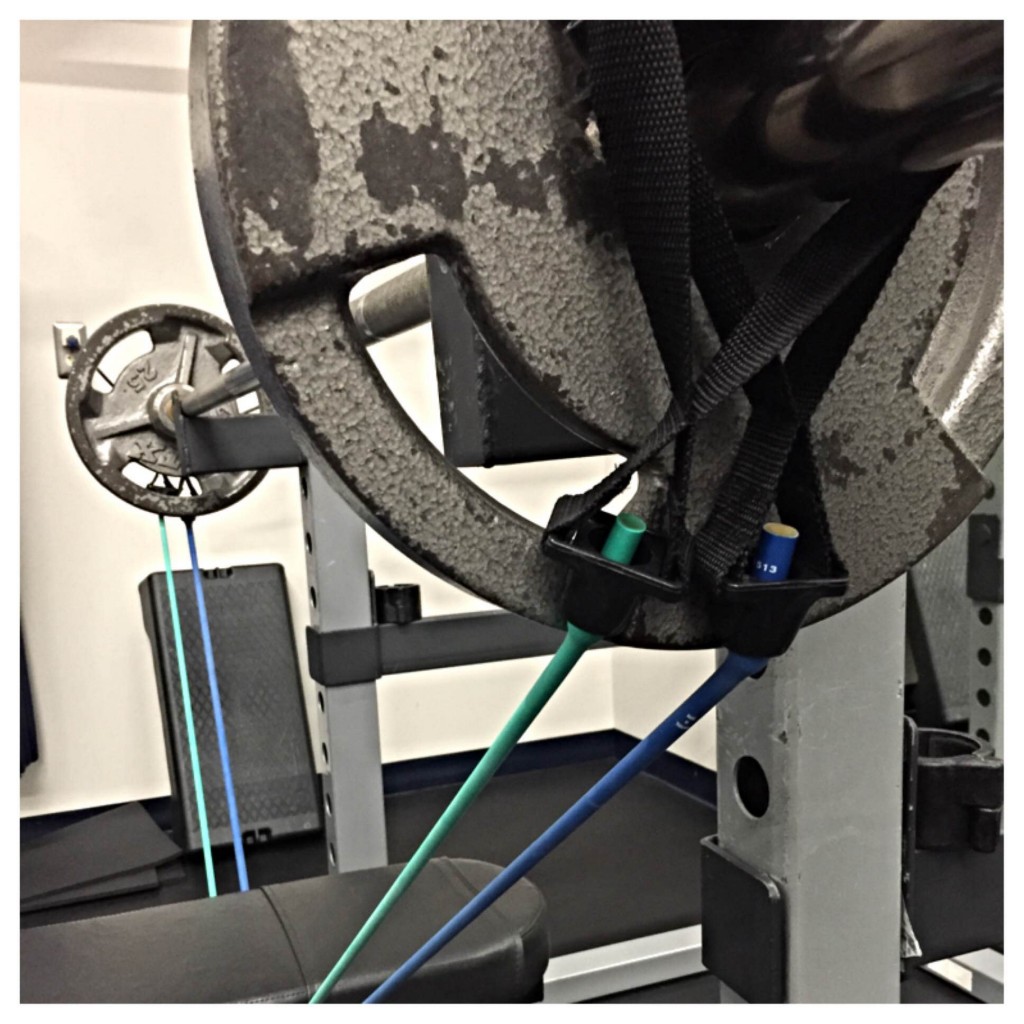 Linear Variable Resistance (LVR) means that the load progressively increases as the range of motion increases. Forms of resistance exercise that utilize LVR include resistance bands, chains and some machines.
Linear Variable Resistance (LVR) means that the load progressively increases as the range of motion increases. Forms of resistance exercise that utilize LVR include resistance bands, chains and some machines.
Picture the barbell bench press with 100 lbs of weight on the bar. For each rep performed, 100 lbs is moved throughout the entire range of motion. Now picture the bench press with 60 lbs of weight along with 40 lbs of resistance bands. At the bottom of the movement, there is 60 lbs, but at the top, when the resistance bands are tight, there is an additional 40 lbs. This variance in load with each repetition is a different stimulus to the body, which can produce beneficial muscular strength adaptations.
Conventional constant-load training (free weights and machines) should remain the “meat and potatoes” of your resistance training program, but research is showing that strength gains can be made when combining LVR and constant-load training.
Who can benefit from LVR?
Anyone who is interested in improving muscular strength can benefit from incorporating forms of LVR into their training. Recent research shows that incorporating LVR into resistance training increases muscular strength gains when compared to constant-load training only. Improvements in muscular strength are correlated with improvements in muscular size, but no data have shown that LVR promotes muscle growth over constant-load training.
One study looked at two groups of young resistance-trained individuals and tested if LVR combined with “constant-load training” would affect the strength and power output as compared to constant-load training only. At the end of the seven-week study, the group that combined LVR with constant-load training showed an average strength increase of 34 lbs on the back squat whereas the constant-load training– only group showed an average of 14.5 lbs of strength improvements. The LVR group also showed 14.5 lbs of strength improvement on the bench press compared to 7.26 lbs of strength improvement in the constant-load training-only group Additionally, the overall power of the LVR group was 52% higher than the constant-load training- only group (Anderson, 2008).
An example of a strength/muscle growth-based workout incorporating LVR and constant-load training might look like this:
• Banded Barbell Squats: 4 x 4-6
• Barbell Romanian Deadlifts: 3 x 8-10
• Banded Barbell Bench Press: 4 x 4-6
• Incline Dumbbell Bench Press: 3 x 8-10
• Banded Barbell Rows: 4 x 4-6
• Lat Pull-down: 3 x 8-10
• Banded Barbell Bicep Curls: 3 x 6-10
• Banded Tricep Push-downs: 3 x 6-10
• Banded Crunch: 3 x 6-10
Conclusion
More research should be conducted on this subject. It is fair to conclude at this point, however, that while constant-load training should not be diminished, adding in a new stimulus like LVR can improve performance.
http://www.strengthandconditioningresearch.com/2013/10/30/variable-resistance-hypertrophy/
About the Author:
-

Michael Stack is the founder & CEO of Applied Fitness Solutions and Frontline Fitness Pros. He is a faculty lecturer for the University of Michigan’s School of Kinesiology. He is also the creator and the host of the Wellness Paradox Podcast, produced in conjunction with University of Michigan.
Michael is an exercise physiologist by training and a health entrepreneur, health educator, and fitness industry advocate by trade. He is dedicated to enhancing the standard of practice of, and advocating for, fitness and wellness professionals to ensure they become an essential constituent in the healthcare delivery system.
With a career spanning over three decades in fitness, health, and wellness Michael has a deep knowledge of exercise physiology, health/wellness coaching, lifestyle interventions to mitigate chronic disease and leadership. He is credentialed through the American College of Sports Medicine (ACSM) as an Exercise Physiologist (ACSM-EP), Exercise is Medicine practitioner (ASCM-EIM), and a Physical Activity in Public Health Specialist (ACSM-PAPHS). Michael is a National Strength & Conditioning Association (NSCA) Certified Strength & Conditioning Specialist (CSCS), and a CDC Diabetes Prevention Program (DPP) Lifestyle Coach.
Michael received his undergraduate degree from the University of Michigan’s School of Kinesiology in 2004 and is currently a Master’s of Public Health (MPH) candidate at University of Michigan, with a specific concentration in health behavior and health education.
Michael is a board of directors’ member for the Physical Activity Alliance and Michigan Fitness Clubs Association. He sits on the University of Michigan’s School of Kinesiology Alumni Board of Governors. Michael is an expert curriculum reviewer for the American College of Lifestyle Medicine. Finally, he is a member of the executive leadership team for American Heart Association’s Heart Walk.
Michael lectures nationally for several health/fitness certification and continuing educations, including; IHRSA, the Medical Fitness Association, the National Strength & Conditioning Association, and SCW Fitness.
